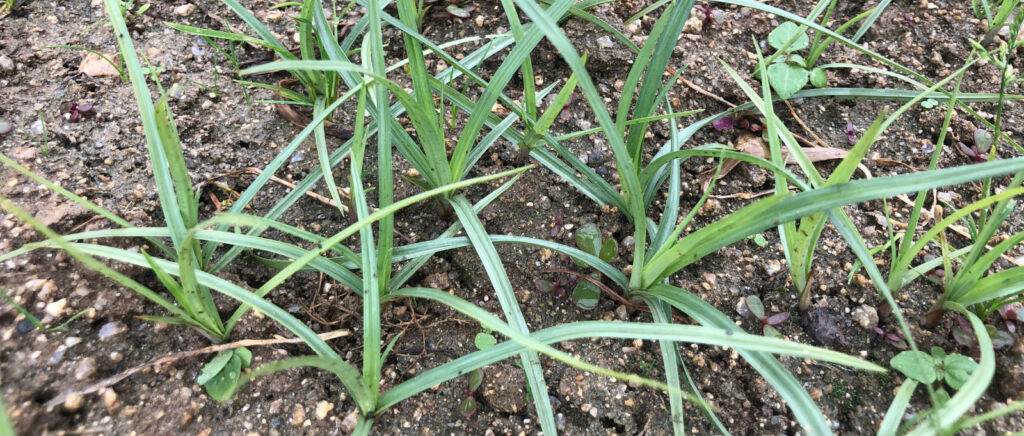Welcome once again to our agricultural section. This time, we’ll study how to grow watermelon. We’ll travel back to its ancestral origins to better understand its behavior. This way, we’ll be able to connect more wisely with a crop that will offer us optimal quality and productive results. We’ll study the entire context of these refreshing fruits, from their agronomic characteristics, their planting process, how to harvest and store them, and their evolution in shapes, sizes, colors, and varieties available to us today.
Furthermore, watermelon is a plant that can be easily grown both in open fields and in small spaces, and in all cases, it brings us great dividends and enormous satisfaction. Another opportunity to continue exploring this vast and beautiful world of cultivation and sustainability.
Historical background of watermelon.

Its scientific name is Citrullus Lanatus. Watermelon is a fruit with a long history, cultivated and appreciated since its emergence in ancient African and Asian civilizations.
Throughout the northwestern region of the African continent, it was first seen as a wild fruit, approximately 4,000 years ago. In several Egyptian tombs in the Saqqara region, we find pictorial representations on some murals, as well as remains of seeds in funerary offerings.
In its African origins, the watermelon appeared as a species with a bitter and tasteless flavor, but highly valued for its high water content, so its domestication process was based on improving its sweetness, enlarging its size and intensifying its color to make it more attractive to the eye and the palate.
Little by little, watermelon cultivation became a very popular agricultural activity due to the progressive opening of trade routes and migrations. It reached India in the 7th century and later China; today, the latter is the largest producer of watermelon in the world.
This agricultural and commercial expansion spread to the Mediterranean and even the Islamic world. In the 10th century, watermelon cultivation was very common on the Iberian Peninsula. It was already known by the name Sindiyyah, “from the region of Sindh,” a province in southern Pakistan where it was cultivated and expanded continuously. In agricultural contexts, especially in the Arab world and countries with Islamic influence, “Sindiyyah” was often used to refer to watermelon.
In the warm, tropical climates of the American continent, watermelon began to be cultivated in the 16th century, especially in North America, where it became very popular. By the 20th century, multiple hybrid varieties had been developed that we consume and appreciate throughout our planet.
https://es.wikipedia.org/wiki/Citrullus_lanatus
Agronomic and morphological characteristics of watermelon.
Let’s start by learning that watermelon is an annual cucurbit. What does this mean?
The Latin “cucurbita” means gourd or bottle, and this is the shape of the watermelon (Citrullus lanatus), melon (Cucumis melo), squash (Cucurbita spp.), cucumber (Cucumis sativus), and zucchini (Cucurbita pepo). These fruits are generally large and creep or climb, forming long, branched stems that can exceed 3 meters in length. They develop tendrils to expand, develop, and attach themselves to the environment, giving their shoots greater security, stability, and solidity.
Watermelon is an annual fruit, as its lifespan is reached after one agricultural year. This means it germinates from the seed, begins vegetative growth, developing until flowering, produces fruit, the seeds ripen and fall, and at the end of this cycle, the plant dies. We will then have to repeat the cultivation process from new seeds. Therefore, the specific characteristics of each variety will define its behavior and adaptation to the environment we have chosen for planting, and the level of yield each plant can achieve.
Its root system comprises a deep, vertical root that produces shallower secondary roots. The deep root requires more than 1 meter of downward penetration and loose, well-drained soil to grow robustly and provide stability to the rest of the plant’s structure. The secondary roots extend to 30 or 40 cm and are responsible for water absorption and nutrient assimilation.
The watermelon stem is flexible and extends from filiform structures (twisted threads growing from the nodes). Secondary shoots develop along the main stem, which can be dark or light green and can reach a length of over 3 meters; this depends on the variety and the soil’s nutritional conditions.
The leaf system is large, palm-shaped, and lobed, designed to capture the sunlight needed for the development of each plant and to maintain a balanced temperature throughout the structure. The leaves are visual indicators that warn us if our crops show signs of water stress or nutritional deficiencies.
The flowers are male and female, located independently on the same plant. The male flowers appear first and in greater numbers; they are small and have stamens. The female flowers appear in smaller numbers and have an inferior ovary recognizable by the naked eye. These flowers are generally pollinated by insects and bees.
Watermelons are berries with thick, smooth or slightly wrinkled skin in shades of green with veins. The juicy, sweet flesh can be red, yellow, or orange, depending on the variety, and their seeds are large, black, or brown. We must prevent our fruit from coming into contact with the soil, as this can cause rot, malformations, and fungal diseases. To do this, we will spread biodegradable paper mulch after preparing the soil and before transplanting or sowing seeds. We will also maintain the correct moisture levels and protect it from weeds and fungi. This will ensure the production of healthy, robust, and excellent-quality watermelons.
Varieties for growing Watermelon.
Let’s review the types of watermelon we have at our disposal today, through natural selection or agricultural and genetic intervention:
Watermelon varieties by seed type.
Here we must analyze the diploid watermelon (WITH seeds) and triploid (without seeds), since the cultivation design, adequate pollination and the requirements that we will take into account to draw our agricultural roadmap will depend on this difference.
If we choose to grow diploid watermelons from seeds, we should know that they are fertile, meaning their seeds can be used for subsequent plantings. These seeds are black, brown, and white, easy to sow, and require no pollination.
Seedless, triploid watermelons originate from a cross between the two types (diploid and triploid), and do require a diploid pollinator or fertile plant to form the fruit. They are in high commercial demand but are more complex in terms of cultivation techniques, so the entire planting process must be carefully planned beforehand.
- Now, if our goal is to grow watermelon in home and urban gardens, we should select diploid watermelons, with seeds and easy to handle, such as the Sugar Baby or Moon and Stars varieties, which we will study below.
- If we plan to grow a large-scale crop, we’ll choose triploid, seedless watermelons, such as the Fashion variety, which are generally in high market demand.
- If we’re looking to grow watermelon for organic purposes, diploid varieties are the best option due to their ease of adaptation and genetic diversity.
Varieties of watermelon by the shape of their fruit.
Shape also matters. Visually, we are drawn to a watermelon with attractive colors and appealing sizes. This has agronomic implications, such as the plant’s genetics, the variety selected, and the agronomic management employed. Let’s study.
Round or globose watermelons:
Suitable for growing in home and urban gardens due to their small, compact size, making them very easy to transport and store. This variety includes the Sugar Baby, Queen of Hearts, and Golden Midget varieties.
Oval or elliptical watermelons:
Ideal for growing on medium to large acreages, they are highly sought after for their elongated fruit size, both for export and wholesale markets.
Here we have the Charleston Gray, Crimson Sweet, Fenway F1, and Style F1 varieties.
Elongated or cylindrical watermelons:
These varieties are characterized by their even more elongated shape than the previous ones, require larger growing spaces, and are suitable for sale in traditional or large-scale markets. This group includes the Charleston Gray variety and the Melona watermelon. The latter is a very sweet watermelon native to Almería, Spain.
Square or specially shaped watermelons:
These fruits are grown experimentally in rigid molds in square, pyramid, or heart shapes. These are not genetic varieties but rather for decorative purposes, and are not usually consumed due to their high cost. Rather, they are offered as exclusive gifts and at gourmet markets. There is one variety in particular for this group: the square watermelon from Japan known as the Cube Watermelon.
Watermelon varieties by rind color.
The Sugar Baby variety has a uniform dark color, Crimson Sweet has a light green color and shows dark striations, and the hybrid watermelon exhibits stripes or mottling.
Watermelon varieties by pulp color.
The intense red variety is the most popular and in high demand in the markets, while the pink or coral variety has a more delicate flavor, and the yellow or orange varieties, such as the Yellow Doll or Orangeglo, have very sweet and exotic flavors.
We will now do a brief analysis of the most notable varieties of watermelon.
Crimson Sweet: juicy, very sweet red flesh, light and dark green striped skin. Popular in America and Europe for its disease resistance.
Sugar Baby: small size (2-5 kg), ideal for home consumption, with a uniform dark green skin and very red flesh. It ripens quickly and has an excellent flavor.
Charleston Gray: elongated shape, weighs between 9 and 14 kg, firm flesh, ideal for long transport, and widely cultivated in warm climates.
Jubilee: very large, weighing up to 18 kg, with striped skin, bright red flesh and excellent heat resistance.
Yellow Crimson and Yellow Doll: yellow flesh, sweet, fruity flavor, very striking and increasingly valued for their color and distinct flavor.
Orangeglo: Bright orange pulp with a complex, sweet flavor. Widely used for fresh consumption and juices.
Seedless or triploid varieties: Seedless Sweet, Nova, Revolution, among others, valued and in high demand in today’s markets due to their ease of consumption.
Watermelon varieties for organic and sustainable farming.
What characteristics should a variety have for growing watermelon in organic gardens?
We must take into account that not all varieties are suitable for this type of planting, as they need to have certain characteristics to achieve successful, high-quality results.
Let’s see what these characteristics are:
They must be naturally resistant to diseases such as powdery mildew, downy mildew, and fusarium wilt, adaptable to water and heat stress. Medium- and short-cycle varieties are recommended to avoid exposure to pest invasion as much as possible. They should preferably come from certified organic seeds and be compatible with crop rotations and associations.
Here we present varieties suitable for organic watermelon planting:
Sugar Baby: diploid (with seeds), fruit weight between 3 and 5 kg, round shape, thin, dark green rind, and intensely red, very sweet flesh. This watermelon has a short cycle of approximately 70 days, easily adapting to urban gardens and small plots, and adapts very well to soils with little fertilization but with the implementation of organic practices.
Crimson Sweet: diploid, fruit weight between 8 and 12 kg, oval-shaped, red, firm, and sweet flesh, with good disease tolerance and widely cultivated in Spain. It withstands long transport journeys. We also offer certified organic versions of this seed variety, suitable for use in sustainable agricultural cooperatives.
Moon and Stars (old): diploid, green rind with yellow markings, hence its name, sweet red or yellow flesh, very hardy, and excellent for storing seeds. This traditional American variety also adapts to Mediterranean climates.
Popular in permaculture and biodynamic farming for its heritage value and hardiness.
Golden Midget: a small diploid cultivar weighing between 1.5 and 2 kg. It has a very short ripening cycle, taking between 60 and 65 days, and has a bright yellow rind and juicy red flesh. It’s perfect for urban or terrace crops, as its short cycle allows for intercropping in short rotations.
Local and ancient varieties: In Spain, many regions have traditional watermelon varieties, and they are highly valued in organic farming. Although they are not permanently available as certified seeds, they are generally preserved in germplasm banks or exchange networks. Their main value is their easy adaptation to the local environment, which makes them more resistant without the need for chemical treatments. This group includes the following varieties: Blanca Watermelon (Murcia), Villaconejos Watermelon (Madrid), and Melona Watermelon (Almería).
Agronomic management for organic watermelon crops.
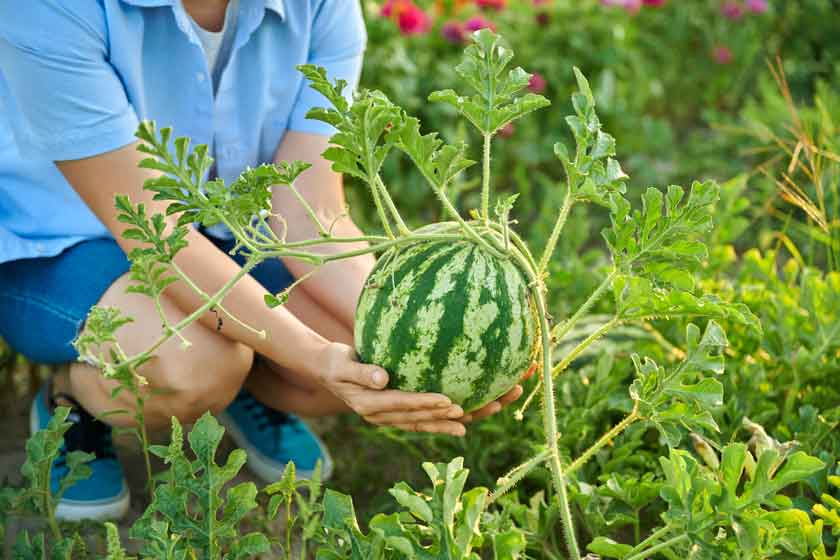
What recommendations should we follow for growing watermelon in organic projects?
- First of all, it is important to do proper research and advice to select the correct variety.
- Crop rotation should be at least three years, meaning we will not repeat the watermelon planting every three years.
- Pair with herbs like basil and marigold: These are excellent insect repellents and essential for growing watermelon; they’re also mutually friendly.
As for fertilization, we’ll need organic fertilizer, compost, worm castings, or manure. All dry and loose. We’ll also need liquid fertilizers with fermented nettle or comfrey extracts on hand.
It’s always advisable to maintain biological control of the crop. This means installing color traps or pheromones, using natural preparations such as potassium soap or garlic extract, and, if possible, introducing beneficial insects such as ladybugs and lacewings to help keep our habitat in good condition.
Implementing the use of biodegradable paper mulch is vital for growing watermelon in these organic fields, as we avoid unexpected investments that we had initially planned, we save on water costs because the paper mulch material retains the necessary moisture throughout the growing process and promotes effective drip irrigation without the risk of waterlogging, and it also inhibits the appearance and proliferation of weeds and fungi.
Agronomic behavior of watermelon according to its varieties.
Each watermelon variety has various characteristics, which we will detail below. These characteristics determine disease resistance, climate adaptability, production capacity, and the generation of fruit suitable for successful marketing, as well as the quality of the agronomic management carried out.
EsLet’s study this behavior according to the main varieties.tudiemos este comportamiento según las principales variedades.
Growing watermelon with seeds (diploid).
General behavior
Sowing times: approximately 80 to 100 days from the start of sowing until harvest.
Hardiness: Almost all traditional varieties have good resistance in open field conditions, although they are susceptible to invasion by pests such as whiteflies, aphids, and fungal diseases such as fusarium.
Yield: Average. Between 30 and 45 tons per hectare under conventional management.
Advantages: good flavor, hardiness and ease of pollination.
Crimson Sweet varieties: requires well-drained soils with a pH of 6.0 to 6.8, is resistant to fusarium wilt and anthracnose, and has heavy fruits, weighing between 8 and 12 kg and easy to transport.
Growing seedless (triploid) watermelon.
General behavior.
Sowing time: slightly longer. Between 90 and 110 days.
Pollination: They need a companion diploid variety as a pollinator, in a 2:1 or 3:1 ratio.
Greater agronomic control required: sensitive to weed competition and water stress.
Hardiness: Almost all traditional varieties have good resistance in open field conditions, although they are susceptible to invasion by pests such as whiteflies, aphids, and fungal diseases such as fusarium.
Yield: can reach up to 50 tons per hectare under irrigation and intensive management.
Advantages: high commercial demand due to consumer convenience.
Fascination varieties (seedless hybrid): high resistance to foliage diseases, uniform fruits between 6 and 8 kg, very firm and sweet pulp, and requires drip irrigation and thermal control in warm areas.
Grow mini watermelon (Sugar Baby variety and similar).
General behavior.
Sowing times: between 65 and 75 days from the start of sowing.
Capacity for high crop density: more can be planted per hectare.
Yield: lighter fruits but in greater quantity per plant.
Advantages: highly appreciated in urban markets and domestic consumption.
Sugar Baby varieties: good tolerance to water stress, fruits between 3 and 5 kg with firm skin and sweet flavor.
Grow watermelon with yellow or orange flesh.
General behavior.
Sowing time: Similar to seeded varieties; between 80 and 95 days.
They require higher temperatures: they benefit from warm soils and good sun exposure.
Lower genetic resistance: some varieties are more susceptible to powdery mildew and downy mildew.
Yield: variable. Between 25 and 40 tons per hectare.
Advantage: visual appeal and exotic flavor.
Yellow Crimson varieties: requires light, deep soils with good phosphorus fertilization. Medium-sized fruit, good post-harvest storage.
Considerations for growing watermelon according to the climate.
Keep in mind that many or almost all watermelon varieties adapt to different climates, so we can include them in several groups.
In temperate climates.
The recommended varieties for these temperatures are those with a short cycle and good tolerance to initial cold: Sugar Baby, Crimson Sweet and Yellow Doll.
In warm and dry climates.
Suitable varieties are seedless or heat-tolerant hybrids such as Melody, Fascination, Revolution, and Crimson Sweet.
In intensive systems with drip irrigation.
In these contexts, seedless watermelons offer high yields if managed precisely with nutritional and health control.
Key agronomic factors for all watermelon varieties.
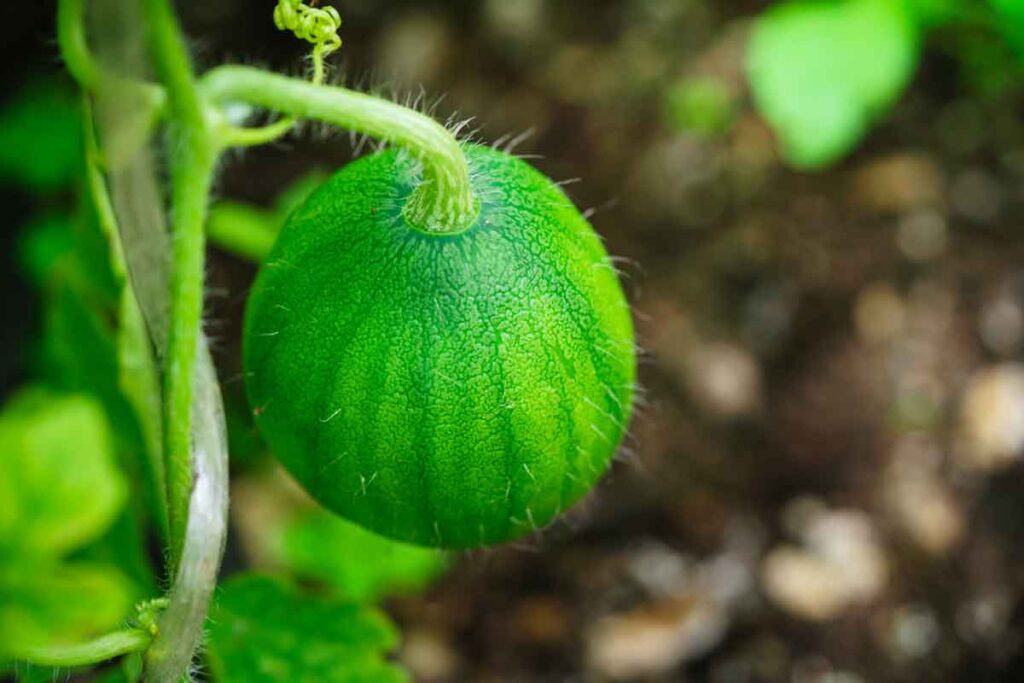
Let’s briefly study some agronomic recommendations for growing watermelon:
- To achieve a suitable soil nature: it must be sandy loam, with good drainage capacity and a pH level between 6 and 7.
- Irrigation: We will water frequently but avoid flooding.
- Fertilization: We add Phosphorus at the beginning of sowing, and at flowering time we add Potassium.
- Pollination: This is vital for seedless or triploid varieties, and whenever possible, it is very beneficial to reinforce it by incorporating bees.
- Health control: It is necessary to periodically monitor our watermelon crop, especially if we detect signs of powdery mildew, anthracnose, or fusarium, which are common in these crops.
What variety should we select before growing watermelon?
When designing our roadmap for growing watermelon, a crucial aspect is choosing the variety based on our available space and investment, soil type, climatic factors, our ability to irrigate adequately, and the destination we’ll determine according to our plan.
Let’s start with the destination we have planned for our crop.
Commercial destination or self-consumption.
Wholesale markets and supermarkets: We recommend uniform varieties with a large size, firm flesh, and good postharvest quality. Here we present the Crimson Sweet and Fascination varieties.
Production for export: Fascination (seedless and very uniform, which is very attractive to the eye.
For home and local consumption: smaller or exotic varieties such as Sugar Baby and Yellow Doll can be chosen.
Local Consumption and Rural Fairs: Charleston Gray, Jubilee, Moon & Stars.
Let’s now review the appropriate climate for some varieties and the growing time according to our requirements.
- Temperate or short-season climates. Keep in mind that many of these varieties adapt easily to different climates: growing watermelon in cool springs and short summers requires selecting short-season varieties such as Sugar Baby, Early Moonbeam, and Yellow Doll.
- Warm climates, tropical and semi-arid zones: medium- to long-cycle varieties such as Charleston Gray, Fascination, Revolution and Crimson Sweet.
Let’s look at the sizes that the fruits we have chosen will acquire and the corresponding variety.
Large watermelon up to 14 kg: Charleston Gray variety.
Medium watermelon between 6 and 8 kg: Fascination variety.
Small watermelon from 2 to 4 kg: Sugar Baby variety (very suitable for easy transport and home consumption).
What are our consumers’ preferences?
At this point, it’s important to conduct a market study; observe our target markets and evaluate which varieties are most appreciated and commercially successful.
Watermelon with classic, sweet red flesh: Crimson Sweet. Watermelon with exotic hues like yellow and orange, and distinctive flavors: Yellow Crimson or Orangeglo.
Which watermelon varieties are most resistant to disease?
If our growing area is prone to diseases such as fusarium, powdery mildew, or downy mildew, we will select varieties such as Crimson Sweet and Jubilee, which are sufficiently tolerant and resistant.
Which watermelon varieties fit into our agricultural roadmap?
Seedless (triploid) watermelons: They are in very high commercial demand due to their ease of consumption, but pollination and the use of more technical and careful resources are necessary to achieve the desired results.
Seeded (diploid) watermelons: They produce fertile seeds, are more hardy, easy to handle, and can be used for future plantings. Highly recommended for home gardens and traditional agriculture. These varieties include Crimson Sweet, Sugar Baby, Moon and Stars, Charleston Gray, Mickylee, and Black Diamond.
Most productive watermelon varieties in Spain.
In this group, we mention the local and traditional varieties of Spain: Melona Watermelon (Almería, Spain), Striped Watermelon of Valencia (Valencian Community), and Rulo Watermelon (Andalusia, Spain). In addition, other species adapt very easily, as we will analyze below.
Crimson Sweet.
Especially in Andalusia and Castilla-La Mancha, this traditional variety is widely cultivated in open fields and prized for its high productivity. Characteristics: Diploid fruit (with seeds), weighing between 8 and 12 kg, with firm, red, and very sweet flesh; each plant produces multiple fruits; it tolerates transportation well and is highly recommended for wholesale and export markets.
Fashion.
One of the best-known and most in-demand commercial seedless varieties in large retail chains, especially in Andalusia. It is a triploid (seedless) variety, weighing between 4 and 7 kg, with deep red, crunchy, and very sweet flesh. It requires the help of diploid pollinators to set its fruit. It produces high yields outdoors, producing uniform fruits with optimal presentation for the consumer, which is why it is in high demand in the market. Very suitable for intensive cultivation.
Fenway F1.
A medium-yielding, highly productive, triploid hybrid variety widely used in professional farms in the Murcia and Almería regions. It weighs between 4 and 6 kg, has fine, sweet, red flesh, produces a large quantity of uniform fruit per plant, and is highly resistant to diseases such as Fusarium and powdery mildew. It adapts to a variety of climatic conditions.
Queen of Hearts F1.
High-yielding and very early, with a high percentage of marketable fruit and excellent consumer acceptance. It weighs between 3.5 and 5.5 kg, is very aesthetically pleasing, rounded, and has a thin, green, veined rind and is recommended for organic farming.
Style F1.
A triploid hybrid variety widely cultivated in the Spanish Levant for its excellent yield and quality. It weighs between 4 and 6 kg, and has round, uniform fruits with very sweet flesh and a firm texture. It is highly tolerant to Fusarium and foliar diseases, and is a long-lived plant with optimal yield per hectare. It is an excellent choice for cultivation using sustainable techniques, both in conventional agriculture and in transitions to organic farming.
Premium F1.
Another highly productive option, specially designed for outdoor cultivation and with good resistance to heat stress. It weighs around 5 kg, with firm, long-lasting fruits. It adapts easily to any season. In southern Spain, growers especially prefer it for promoting export campaigns to European countries.
How to grow watermelon in different environments? Soil preparation and climate requirements.

We will examine the agricultural processes of watermelon cultivation in open fields, in small spaces such as greenhouses, home gardens, urban gardens, terraces, and balconies.
Let’s start by growing watermelon in the open field.
This is a widespread practice in many regions of Spain, especially in warm areas with good sunlight. Growing watermelon in open fields allows us to obtain large fruits with excellent flavor and optimal market quality.
However, we’ll consider some vital steps to ensure our production reaches the expected level. This means we’ll be closely monitoring everything from land preparation to harvesting and storing our produce.
Especially in these open-field cultivation situations, the use of biodegradable paper mulch is an indispensable aid that provides many benefits. These include inhibiting the growth and proliferation of weeds and fungi, minimizing water costs, and maintaining excellent soil quality throughout the planting process.
Watermelon naturally originates from warm, dry climates and therefore requires very specific environmental conditions to grow vigorously and robustly, set its fruit well, and ensure profitable and abundant production.
It’s important to study the climatic factors or thermal conditions here to choose the right time to start planting, our water availability, the appropriate area, and the agricultural techniques we’ll implement throughout the planting process. Let’s study.
The minimum temperature required to begin the germination phase is 18°C, an ideal warm atmosphere for these plants. We’ll avoid temperatures below 15°C to allow for natural germination. During the day, we’ll try to maintain 24 to 30°C, and at night, we’ll aim for 18 to 22°C. The daily constant, then, ranges between approximately 22 and 28°C.
Because it originates in warm regions with good sunlight exposure, watermelon requires a minimum of 6 hours of direct sunlight, and even better if it receives between 8 and 10 hours of high light daily, so that its vegetative organs can develop properly and sugar synthesis in the fruit is promoted.
If we live in regions with frequently cloudy climates, we recommend growing watermelon in a north-south orientation to maximize sun exposure.
These crops prefer dry, sunny environments with low to moderate relative humidity between 50% and 70%. If our planting area is located in humid regions, we will use biodegradable paper mulch to act as a barrier against excess soil moisture and thus preserve the drier foliage.
In areas with frequent rainfall and a tendency toward waterlogging, watermelon is not suitable for growing, as it accepts moderate and sporadic watering to properly develop its structure.
Likewise, if we need to plant in these areas, we’ll need to create ridges and spread biodegradable paper mulch beforehand to control these moisture levels and prevent our fruit from coming into direct contact with the soil or mud.
Furthermore, paper mulch will allow excess drainage to flow away, channel away, and retain adequate moisture to protect the plant’s root system.
Our last point to consider is the wind factor. It’s advisable to grow watermelon in naturally protected areas, either through hedges, walls, or by implementing agricultural windbreaks or planting rows parallel to the direction of intense wind gusts.
How to grow watermelon in home and urban gardens?
Yes. It is possible to grow watermelon in a more local way, one that we can learn and enjoy at home or in areas close to our daily lives.
We currently have access to certain varieties that are adaptable to small spaces, and advanced and efficient cultivation techniques that allow us to produce fruit of optimal quality. Among these watermelon varieties, we find those with short cycles and good agronomic performance under non-industrial conditions.
Let’s analyze the properties of these varieties, but in general, we should choose those that produce small or medium-sized fruits, plants with controlled growth or less capacity for expansion, and short cycles, meaning those with a time of less than 80 days from planting to harvest. They must be resistant to pests and diseases and have the ability to adapt and produce good-quality fruits in these small and medium-sized spaces.
Let’s look at some varieties suitable for these small environments:
Sugar Baby: One of the best-known and most appreciated varieties for its ability to adapt to small spaces. It is a diploid (seeded) cultivate with a short cycle of 70 to 75 days. Fruit weight ranges from 3 to 5 kg, and is round in shape with red, sweet, and juicy flesh. It can be planted in large pots and growing trays. Each plant produces a good amount of fruit and requires little maintenance. It can also be grown on sunny terraces in pots of at least 40-50 liters.
Golden Midget: This miniature variety is highly valued in urban gardens for its very short cycle, producing single fruits. Its diploid fruit weighs between 1.5 and 2 kg, with sweet red flesh. When ripe, it has a bright yellow rind that is very attractive to the eye. Its cycle is very short, ranging from 60 to 65 days, and it also adapts easily to small spaces. It is a very suitable plant for rapid rotations, which means we can harvest several times within a single season, and its cultivation process is convenient in wide planters.
Mini Love F1: A diploid hybrid variety developed for compact gardens and home gardens. Fruit weight is 2 to 3 kg, with deep red flesh and a crunchy texture. It produces a thin, green, veined rind and has a fruiting cycle of approximately 75 days. It has a delicious flavor, is visually very attractive, and is resistant to common diseases. It can be grown in patios with soil or in raised beds, and requires support for vertical growth. It is also suitable for use on walls or trellises.
Little Darling F1: This is also a small hybrid watermelon, designed for home consumption. It weighs 2 to 4 kg, and has red, very sweet flesh. It is a compact, hardy, and slow-growing plant that produces small, uniform, and numerous fruits. Very suitable for small gardens or urban greenhouses.
Moon and Stars (dwarf version): This ancient, ornamental species is ideal for growing in educational gardens, direct sowing in raised beds, and permaculture. It weighs 2 to 5 kg, has red or yellow flesh depending on the subvariety, and has a dark green rind with yellow markings. It is also very visually attractive and tolerates adverse conditions fairly well. While it is not very productive, its aesthetic value and natural hardiness make it excellent for school or family projects.
How to grow watermelon on terraces and balconies?
The essential characteristics we must consider are: compact plants and fruits with short cycles of 60 to 80 days, disease-resistant, and adaptable to high-quality growth in containers such as pots and raised beds. They require good sunlight exposure and controlled irrigation to avoid waterlogging.
We present some watermelon varieties very suitable for these environments.
Sugar Baby: With fruits weighing 3 to 5 kg and a short cycle. Suitable for growing in large pots.
Golden Midget: mini watermelon weighing 1.5 to 2 kg and very short cycle.
Mini Love F1: hybrid, sweet, firm and compact pulp.
Little Darling F1: low plant with small fruits.
Dwarf Moon and Stars: ornamental and very productive in planters.
We recommend using:
Large pots or growing tables with a depth between 40 and 60 liters to place a seedling in the case of pots, and several at a distance that we will study later so they can develop comfortably.
Long planters placed on terraces and balconies with plenty of sunlight and sufficient drainage capacity.
Raised beds in patios or community gardens, and vertical spaces if we are going to use tutors or trellises.
If we want to grow watermelon in these confined spaces, we need at least six hours of direct sunlight, with adequate protection from frequent wind and rain, and the ability to stake or anchor the trees to redirect them as they grow.
Preparing the container or bed to grow watermelon.
If you’ve decided to plant watermelon in pots or containers, add a drainage layer of gravel or medium-sized stones to the bottom, then cover with a light substrate made of organic matter such as compost, coconut fiber, peat, or worm castings. The containers you choose should be at least 40 cm deep and have enough holes for proper drainage.
The first waterings should be done early in the day, lightly and continuously, and drip irrigation is even better. We’ll allow the soil to absorb the liquid sufficiently between irrigations. As our crop grows, we’ll space out the waterings to improve the flavor of the fruit.
Watermelons can be planted directly in the soil, once properly prepared and provided the temperature is above 18°C or 20°C. Place 2 or 3 seeds per hole, approximately 2 cm deep. When sprouts begin to appear and germination begins, select the most robust seedling and remove the weakest.
At the transplant stage to the final soil, if applicable, we select those seedlings that have developed between 3 and 4 true leaves, and we must place 1 plant per pot to avoid competition for nutrients and water.
We’ll need to use staking to control the growth pattern, guiding the stems with canes and rope. We can also use netting and supports to prevent our stems from hanging down and risking breaking. We can also cut off the top flowers to slow down their growth.
How to grow watermelon in greenhouses?
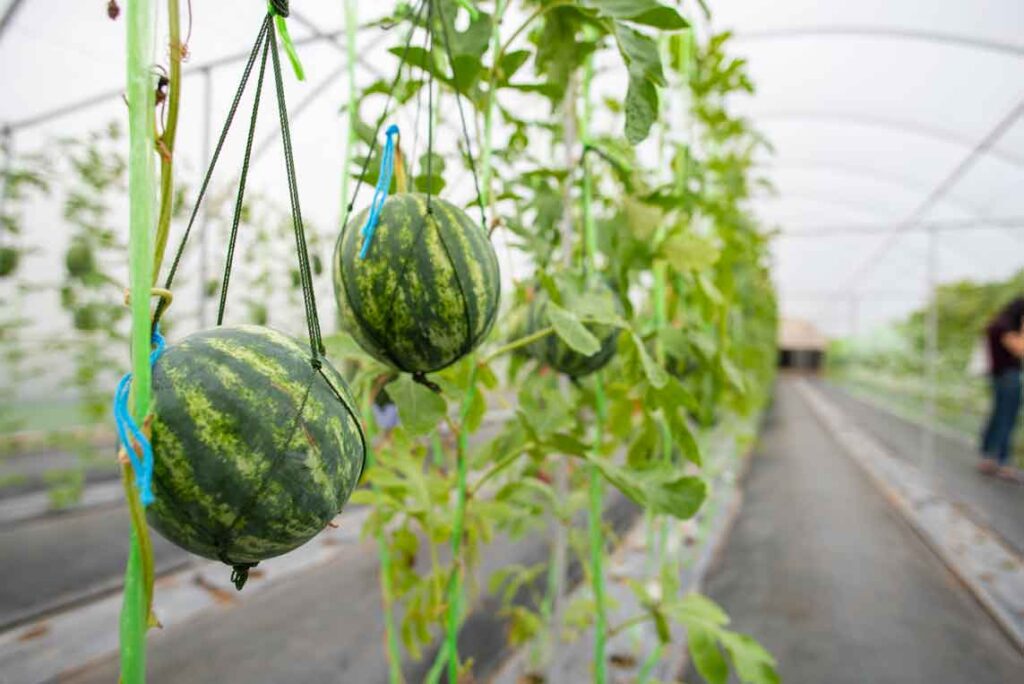
When designing our roadmap for growing watermelon in a greenhouse, we should know that we will gain several advantages, allowing us to advance or extend the season, improve yield, and protect the crop from adverse weather conditions such as rain, hail, wind, or frost.
If we advance or extend our greenhouse harvests, we can access the market at much more profitable dates and times.
Likewise, we can control pest infestations and the spread of diseases, and if we use biodegradable paper mulch, we can prevent splashing on our fruits and increase their quality, as they will develop in more stable and healthy conditions.
We’ll add that growing watermelon in greenhouses allows us to produce with excellence in non-traditional regions and colder, wetter climates or those with adverse weather fluctuations. At the same time, we have the opportunity to choose the cultivation method that best suits us: conventional, organic, or integrated agriculture with cutting-edge technology such as the use of biodegradable paper mulch.
Among the watermelon varieties recommended for greenhouse cultivation, we will select those that produce effective fruit set in controlled areas (to produce flowers), produce medium-sized, uniform fruits, and have medium or early cycles. They must have good resistance to common soil and plant structural diseases.
We present a list of varieties suitable for greenhouse planting:
Fashion: seedless triploid and high commercial demand.
Fenway F1: high productivity and very uniform.
Style F1: excellent flavor and crunchy texture.
Queen of Hearts F1: aesthetically pleasing and very precocious.
Crimson Sweet: traditional diploid and very good for pollination.
Preparation of the land and structure of the greenhouse.
Recommended structure: High tunnel or multi-tunnel type with good lateral and overhead ventilation. Minimum height: 2.5 to 3.5 meters. Covering material: Shade mesh or combinations of sustainable materials.
Soil: Loose, deep, well-drained. Optimum pH: 5.8 to 6.8. In organic farming: use compost or mature manure. In conventional farming: soil analysis and nutrient correction.
Raised ridges and biodegradable paper mulch: To improve drainage. To facilitate root development. To prevent fruit from coming into contact with soil moisture.
Dimensions: Height: 20 to 30 cm. Width: 60 to 80 cm. Row spacing: 1.8 to 2.2 m.
Biodegradable paper mulch: Paper mulch is especially recommended in greenhouses: To prevent weed growth. To retain soil moisture. To regulate temperature at the root level. Because it leaves no plastic residue, biodegrades, and serves as a compostable and highly nutritious material. Because it is suitable for organic farming and systems that seek to reduce waste and disposal costs at the end of the crop.
Transplant method for growing watermelon in a greenhouse.
This is the best way to control seedling development, while achieving much greater fruit consistency and optimizing the schedule from the start of sowing to harvest.
The procedure to follow will be as follows: we will sow seedlings with 3 to 4 true leaves, making holes (in the paper mulch spread on the surface of the soil), sufficient to house each seedling with a distance between 0.8 to 1 meter between them, and placed in lines at a distance of 1.8 to 2.2 meters.
The appropriate irrigation is by linear or branched drip, with a frequency according to the climate and the phase of the crop.
Crop fertilization: Base fertilization, adding compost, humus, or complex fertilizers, depending on the system. Fertigation, applying nitrogen during vegetative growth, and potassium and phosphorus during flowering and fruit set.
Pollination of watermelons in a greenhouse.
Watermelon requires entomophilous pollination, the process by which insects transport pollen from the male flowers to the female flowers of the plant, allowing for fertilization and the formation of fruits and seeds. This fertilization in the greenhouse should be achieved by introducing hives of bees or bumblebees whenever possible, interspersing flowering plants, or hand-pollinating in small gardens. Remember that seedless (triploid) varieties will not produce fruit without effective pollination.
Harvest times in the greenhouse from transplant will be between 70 and 95 days, depending on the variety chosen and the climate. The fruits will have reached maturity when we observe these signs: a dry tendril, a yellowish fulcrum, and a hollow sound when tapped.
Biodegradable paper mulch for optimal watermelon cultivation.
What is biodegradable paper mulch?
It consists of a sheet made from plant fibers. These fibers are carefully prepared with environmentally friendly materials that are completely respectful of the ecosystem. They are designed to resist and control humidity levels throughout the growing cycle. They degrade and integrate naturally into the soil at the end of the process.
This design generates no waste and meets all industrial and home compostability criteria, replacing the use of agricultural plastic and contributing to optimal crop results in any environment we choose.
Specifically in watermelon cultivation, paper mulch plays a vital role, inhibiting the emergence and proliferation of weeds such as sedge from the beginning of planting to harvest time. It also controls soil temperature, maintaining the necessary moisture so that the root system and the rest of the plant’s structure remain healthy and absorb all the nutrients necessary for its development and production of robust, top-quality fruit.
When we use paper mulch, we protect the fruit that rests directly on the ground, thus eliminating the risk of prolonged contact with moisture that causes fruit rot, as well as the appearance of stains caused by fungi or bacteria that nest in the soil. Furthermore, the paper mulch material prevents soil malformations such as cracking or unexpected high temperatures.
Buy biodegradable paper mulch here
-
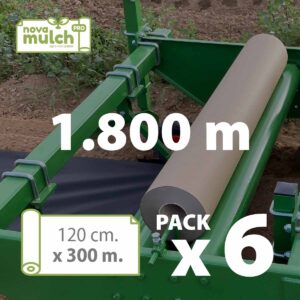 PACK of 6 rolls of Novamulch Professional paper 120 cm. x 300 m. (1.800 m)565,28 € IVA incluido
PACK of 6 rolls of Novamulch Professional paper 120 cm. x 300 m. (1.800 m)565,28 € IVA incluido -
 PACK of 3 rolls of Novamulch Professional paper 120 cm. x 300 m. (900 m)282,22 € IVA incluido
PACK of 3 rolls of Novamulch Professional paper 120 cm. x 300 m. (900 m)282,22 € IVA incluido -
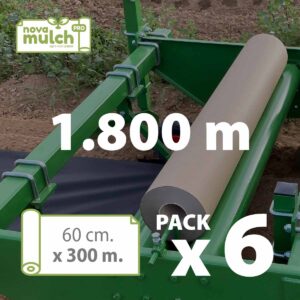 PACK of 6 rolls of Novamulch Professional paper 60 cm. x 300 m. (1.800 m)282,22 € IVA incluido
PACK of 6 rolls of Novamulch Professional paper 60 cm. x 300 m. (1.800 m)282,22 € IVA incluido -
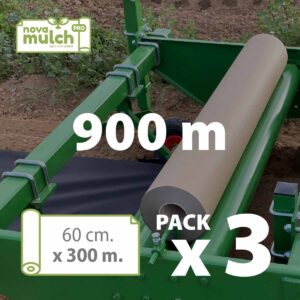 PACK of 3 rolls of Novamulch Professional paper 60 cm. x 300 m. (900 m)141,30 € IVA incluido
PACK of 3 rolls of Novamulch Professional paper 60 cm. x 300 m. (900 m)141,30 € IVA incluido -
 Novamulch Professional Paper 120 cm. x 300 m.94,21 € IVA incluido
Novamulch Professional Paper 120 cm. x 300 m.94,21 € IVA incluido -
 Novamulch Professional Paper 60 cm. x 300 m.47,10 € IVA incluido
Novamulch Professional Paper 60 cm. x 300 m.47,10 € IVA incluido -
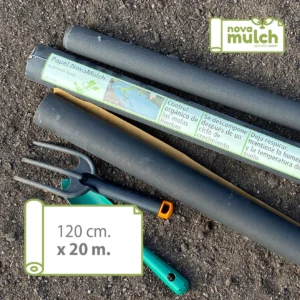 Novamulch paper 120 cm. x 20 m.41,63 € IVA incluido
Novamulch paper 120 cm. x 20 m.41,63 € IVA incluido -
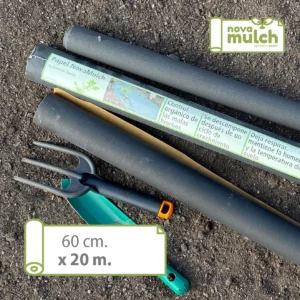 Novamulch paper 60 cm. x 20 m.21,89 € IVA incluido
Novamulch paper 60 cm. x 20 m.21,89 € IVA incluido -
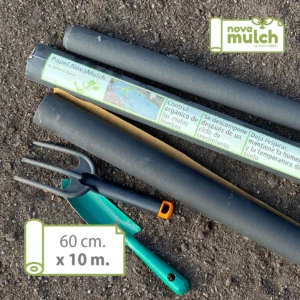 Novamulch paper 60 cm. x 10m.14,85 € IVA incluido
Novamulch paper 60 cm. x 10m.14,85 € IVA incluido -
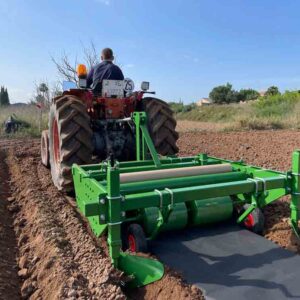 Novamulch agricultural mulching machine
Novamulch agricultural mulching machine
Fertilization and maintenance of watermelon crops.
Continuing with our watermelon-growing project, we now touch on the essential stages we must take care of. It’s always more convenient to keep a growing log so we have every step of the process at hand. Let’s review the following steps.
Preparatory fertilization before planting or transplanting: We will first nourish the soil or make the necessary amendments for successful rooting. To do this, we need to add organic matter such as mature, dry, and well-crushed manure, worm castings, and equally dry and loose compost. We then apply phosphorus-rich fertilizers so that, when well incorporated with the rest of the nutrients, they promote rooting and subsequent flowering.
When planting or transplanting seedlings, we begin the vegetative phase, during which roots, stems, and first leaves begin to develop. During this stage, moderate doses of nitrogen are required, and we add more doses of phosphorus. Drip irrigation should also be moderate every 7 to 10 days.
Approximately 30 to 50 days after sowing or transplanting, we begin the flowering and fruit set stage, during which we reduce nitrogen doses to prevent excessive leaf development. We increase the doses of potassium or potassium monophosphate to promote this phase of fertilization and the appearance of the first fruit shoots.
We continue with the fattening and ripening phase 50 days after the start of the crop. This is a delicate stage because we must take note of all the doses we will apply to adequately achieve the size, firmness, and sweet flavor of our fruits. We will increase the potassium doses and maintain the levels of calcium and magnesium, which are also essential micronutrients. During this phase, we will avoid excessive irrigation and nitrogen, so we can preserve and not dilute the appropriate amounts of sugars in the fruits.
Let’s pause now to record a brief nutrient and micronutrient diagram in our growing log:
Nitrogen (N): essential in the vegetative growth phase, to develop leaves and stems.
Phosphorus (P): to promote good rooting and initiate excellent flowering.
Potassium (K): essential for setting, fruit size and correct sugar content.
Micronutrients: Calcium (Ca) and magnesium (Mg): strengthen cellular structure and disease resistance. Boron, zinc, and manganese in measured amounts.
When growing watermelon in organic projects, fertilization is based on adding natural products and beneficial microorganisms. There are several options:
Homemade or commercial compost: it is the essential organic base.
Mature manure: horse, sheep or cow, well fermented, loose, dry and crumbled.
Liquid fertilizers: These include nettle slurry, compost tea, and comfrey extract.
Rock dust and wood ash: as an excellent source of potassium and phosphorus.
We can supplement with mycorrhizae or nitrogen-fixing bacteria to enrich the microbial life of the soil.
Maintaining watermelon crops.
In addition to fertilization at the times we’ve analyzed, we’ll need to add additional agronomic maintenance tasks to promote the development of our crops and protect them from pests and diseases. In urban and domestic gardens, other small spaces, and greenhouses, we’ll need to use stakes to support the verticality and weight of the entire plant structure.
In open field.
The guides or tutors should be oriented so that the entire crop can have access to the observation stages by us, for proper pollination and aeration.
At this point, it’s important to remove any misshapen or poorly positioned fruits, leaving two to four robust, main fruits so we can improve the quality of the final size. We also remove malformed and stained leaves and take care to keep the stems clean and free of buds, so that each plant can redirect its vital energy toward producing better flowers and fruits.
Harvest and storage times for watermelons.
We’re in the final stage of our roadmap. However, growing watermelon doesn’t end there; the process is a bit more delicate. Harvesting our fruit must be as precise as possible, because if we harvest early, we’ll end up with tasteless fruit or fruit with unpleasant textures, and if we harvest late, the fruit will crack, split, or begin to pass its freshness and health. This is why our crop log is essential, so we can make the necessary and accurate, or nearly accurate, calculations for completing each phase, especially this one.
The average time from sowing or transplanting to harvest depends on several factors, such as the variety selected, the climate and average temperature of the growing area, the environment in which we planted our crops, and the planting method used; whether it was direct sowing or transplanting.
Let’s then analyze the development cycle times, so that we can calculate more accurately:
Early varieties: between 70 and 80 days from the start of sowing or transplanting.
Standard varieties: 85 to 95 days.
Late or large varieties: 100 to 110 days.
In urban gardens and smaller spaces, and under favorable planting conditions, some varieties, such as Golden Midget, can be harvested in 65 days.
We will know when our fruits are ready to harvest if we notice that the tendrils that appear near the peduncle are completely dry, if the part that rests on the ground changes to shades of cream or dull yellow, if we hear that when gently tapping the bark with the knuckles a deep and vibrant sound is produced, if the bark loses the intense shine that characterizes it from its immature phase, if when holding them effortlessly we feel that they weigh in the dimension of their size, no more, no less.
To be sure, in case we have any doubts, we will open a sample and examine the color, texture, and flavor of the pulp.
The watermelon should be carefully cut from the stem to avoid damage. Use sharp, disinfected scissors or knives, leaving a small piece of the stem attached to the fruit.
If we have used biodegradable paper mulch, we avoid unnecessary unforeseen events because the mulch allows all the fruit to rest on this material, which remains clean, thus reducing the incidence of stains, rot, or mechanical damage during harvest time.
Storing watermelon after harvest.
These fruits do not continue to ripen after being harvested, which is why we insist on keeping a crop log in which we note the planting schedule, so we can choose the right time to harvest the fruits and obtain top-quality products.
The appropriate conditions for storing watermelon are as follows:
Store them at an average temperature of 10° to 15°C with a relative humidity of 85° to 90°C. Ventilation should be moderate to avoid condensation. If we store the fruits whole, they can be stored for 2 to 3 weeks depending on the variety. Once cut, they can be refrigerated for 3 to 5 days.
When growing watermelon in small spaces, it’s important to pick only the fruit you plan to consume, storing the rest in cool, shaded areas such as north-facing balconies or well-ventilated, moisture-free pantries.
Transportation and marketing after harvest and storage.
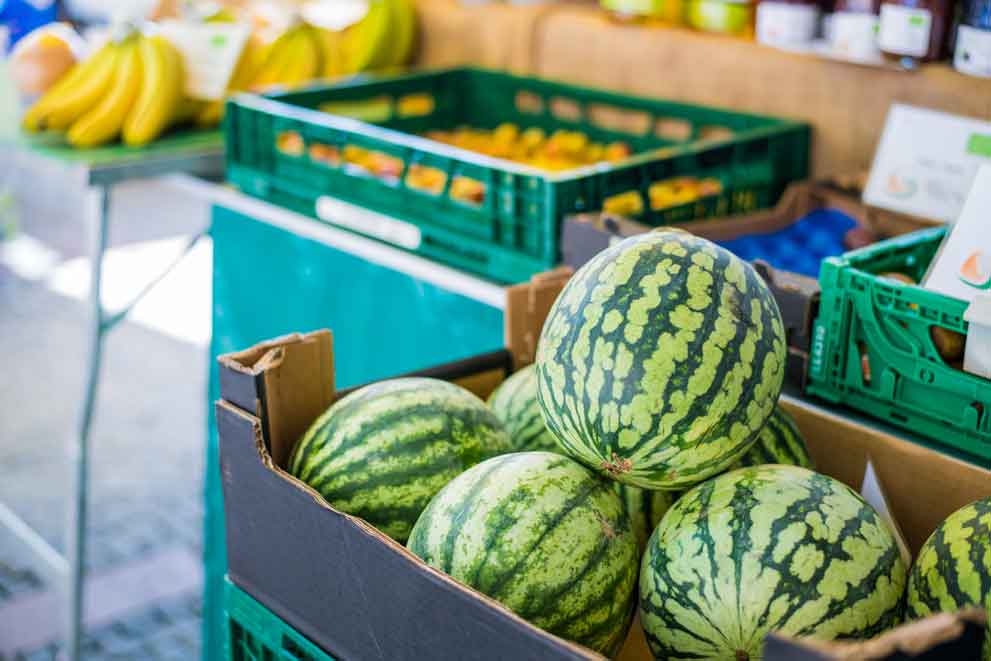
In professional agriculture, watermelons must be handled with special care. We place them in padded boxes or cages, not stacking them more than two levels high without protection. It’s important to keep records labeling the batch, variety, and harvest date. We will use refrigerated vehicles if the route takes more than 12 hours or the ambient temperature exceeds 30°C.
Common pests and diseases to consider before growing watermelon.
These fruits are susceptible to a number of common pests and diseases that can affect both their vegetative development and the quality and health of our production. Furthermore, since they are vectors of viruses and secondary diseases, they will ravage all our crops, causing significant economic losses and a serious deterioration in the commercial quality of our products.
For this reason, we are going to study first the Pests that can affect these crops.
Aphids (Aphididae).
Most common species: Aphis gossypii (cotton aphid) and Myzus persicae (green peach aphid).
Damage they cause: They suck sap from young shoots, leaves and flowers, excrete honeydew that promotes the appearance of sooty mold (saprophytic fungus), and are vectors of viruses, such as cucumber mosaic virus (CMV).
Symptoms: Rolled and deformed leaves, loss of vigor, and presence of honeydew and ants.
Solution: Biological control, introducing ladybugs (Coccinella) and lacewings (Chrysoperla), applying potassium soap or neem oil, and spreading biodegradable paper mulch that makes it difficult for colonies to rise from the ground.
Whitefly (Bemisia tabaci and Trialeurodes vaporariorum).
Damage they cause: They are found on the underside of leaves and suck sap. Like aphids, they secrete honeydew. They can transmit viruses such as tomato yellow leaf curl (TYLCV), which also affects cucurbits.
Symptoms: Leaves with chlorotic spots, yellowing and premature fall, and poorly developed fruits if the infestation is intense.
Solution: Use yellow chromatic traps for monitoring, introduce natural enemies such as Encarsia formosa, and in the case of organic farming, apply potassium soap and garlic extract.
Thrips (Frankliniella occidentalis, Thrips tabaci).
Damage they cause: They feed by scraping tissues from leaves, flowers and fruits, damaging surface cells and causing silver spots or scars, and are often vectors of the tomato spotted wilt virus (TSWV).
Symptoms: Silver or bronze spots on young leaves, flower deformations, and superficial scars on fruits.
Solution: Blue traps, neem extract and natural pyrethrins (in organic), and insect-proof nets in the greenhouse.
Red spider (Tetranychus urticae).
Damage caused: It settles on the underside of leaves and sucks out cell contents; it develops fine cobwebs in severe infestations.
Symptoms: Yellow stippling on leaves, general discoloration and premature drop of foliage, and reduction in the size and number of fruits.
Solution: high humidity levels reduce their activity (except in excess), introduction of natural predators such as Phytoseiulus persimilis, and micronized sulfur in preventive applications (according to local regulations).
Leaf miner (Liriomyza spp.)
Damage they cause: The larvae dig galleries between the layers of the leaf and affect the plant’s photosynthetic capacity.
Symptoms: Whitish lines or meandering “paths” on leaves, loss of functional tissue, and increased susceptibility to fungal diseases from open wounds.
Solution: Removal of infected leaves, yellow sticky traps, and garlic and tobacco preparations (in organic farming).
Caterpillars and larvae of lepidopterans.
Common species: Spodoptera exigua (green doughnut), Helicoverpa armigera (tomato caterpillar).
Damage they cause: They feed on leaves, flowers and developing fruits, and can pierce the fruits, rendering them unusable at the market level.
Symptoms: Visible holes in leaves and fruits, traces of excrement at the base of the plant, and malformed or split fruits.
Solution: sex pheromones for mass capture, Bacillus thuringiensis (in organic), and manual removal in small gardens.
Soil nematodes (Meloidogyne spp.).
Damage they cause: They are microscopic and attack the roots, forming galls or deformations, and limiting the absorption of water and nutrients.
Symptoms: Stunted plants, general yellowing, and very poor fruit set.
Solution: Crop rotation with non-host species, application of organic matter rich in antagonistic microorganisms, and prior soil solarization in open-field crops.
Preventive recommendations for pest invasion in watermelon crops.
Regularly monitor the crop, promote ecological balance with natural enemies, and use physical barriers such as netting and even biodegradable paper mulch, which improves overall crop health by keeping the environment clean and dry.
The use of natural products and sustainable practices not only protects crops but also reduces dependence on chemical treatments and promotes a healthier agricultural system.
Common diseases of watermelons: identification, prevention, and sustainable control.
The ideal conditions for sensitizing our watermelon crop and making it prone to generating these diseases are mainly living in conditions of high humidity, high temperatures, and poorly managed soils:
Powdery mildew (Sphaerotheca fuliginea, Erysiphe cichoracearum).
Identification: presence of white or grayish powder on the surface of the leaves, especially on the upper surface, wrinkled, dry or deformed leaves, limited plant development and reduced yield.
Favorable factors: temperatures between 20° and 30°C, and high relative humidity.
Prevention and control: Ensure good ventilation between plants, avoid excess nitrogen, preventative application of micronized sulfur (in organic farming), and horsetail extracts or potassium bicarbonate as alternative treatments.
In these cases, the use of biodegradable paper mulch reduces moisture at the base of the crop and prevents spores from rebounding from the soil.
Downy mildew (Pseudoperonospora cubensis).
Identification: Angular yellow spots on the upper surface of the leaf that turn brown, grayish or purplish mold on the underside, premature leaf drop, and a drastic decrease in yield.
Favorable factors: high relative humidity, at levels of 90%, frequent rainfall or sprinkler irrigation, and mild temperatures, between 18° and 24°C.
Prevention and control: crops grown in well-drained ridges, drip irrigation instead of sprinklers, and applications with nettle infusion or copper preparations (in organic farming). Paper mulch acts as a barrier in these situations, preventing water from splashing from the soil onto the leaves, thus interrupting the pathogen’s cycle.
Fusariosis (Fusarium oxysporum f.sp. niveum).
Identification: Progressive yellowing of the leaves, starting with the lowest, wilting during the hottest hours, which may recover at night, darkening and necrosis of the conducting vessels in the stem and root.
Favorable factors: poorly drained soils or those with a history of infections, and temperatures between 20° and 28°C.
Prevention and control: use of resistant varieties (there are triploid hybrids with genetic tolerance), crop rotation (minimum 4 years without cucurbits), and improving soil structure with compost and biofertilizers.
Biodegradable paper mulch improves the root environment, preventing excess moisture from reaching the neck of the plant.
Anthracnose (Colletotrichum orbiculare).
Identification: Circular, sunken brown lesions on leaves, stems, and fruit. The latter have sunken, water-soaked spots with dark margins. Defoliation and yield decline are present.
Favoring factors: warm and humid climates, and high plant density without ventilation.
Prevention and control: removing infected crop debris, applying garlic extract, copper, or propolis (in organic farming), and using biodegradable paper mulch to keep the fruit off the ground. This also prevents the fungus from spreading from plant debris in the soil.
Collar rot (Didymella bryoniae).
Identification: sudden loss of turgor, necrosis at the neck of the plant (point of contact with the soil), soft, watery tissues and a foul odor if complicated by bacteria.
Favorable factors: waterlogged or poorly aerated soil and direct contact of the stem with moist debris.
Prevention and control: Avoid contact of the stem with bare soil, deep tillage and efficient drainage, and the application of mycorrhizae or trichodermas in organic treatments.
Biodegradable paper mulch is key to preventing this disease, as it insulates the stem from direct contact with mud or moisture.
Cucumber mosaic virus (CMV).
Identification: Leaf mottling or mosaic: yellow spots or deformations, stunted growth and malformed fruits, and is transmitted by aphids and other pests.
Favoring factors: presence of vectors (insects), inadequate tool hygiene practices.
Prevention and control: biological control of aphids and whiteflies, use of certified and healthy seeds, and immediate removal of plants with symptoms.
Paper mulch limits weed growth and moisture, delaying the emergence of vectors.
Let’s take note of these preventive measures so we can be clear about all the aspects we need to control:
Crop rotation and use of resistant varieties, application of organic matter and beneficial microbiology (trichodermas, mycorrhizae), installation of drip irrigation and biodegradable paper mulch, visual monitoring and removal of affected plants, avoiding waterlogging and maintaining good ventilation.
Final Reflections.
Growing watermelon is an activity we should always add to our agricultural roadmaps. Dreaming of planting watermelons in unexpected places like terraces, balconies, home gardens, urban gardens, greenhouses, and our open fields…
Did we ever imagine it? This is an experience that surely leaves us with a deep learning experience and gratitude for allowing us to connect with and enjoy the rhythms and processes of the earth, and to be the wise architects of the creation of plant life, enjoyment, and productivity.
We’ve learned how to create our grow log, a daily notebook in which we keep track of all the details and events of our activity. From the day we see the first shoots, the first flowers, and the first fruits appear, we’ve also learned how to be alert and prepared with the right knowledge and tools to deal with unexpected and unwanted events (we already know about pests and diseases) and how to solve them while respecting our beautiful environment.
Thus, growing watermelon represents a source of agricultural wealth of which we are an integral part.

